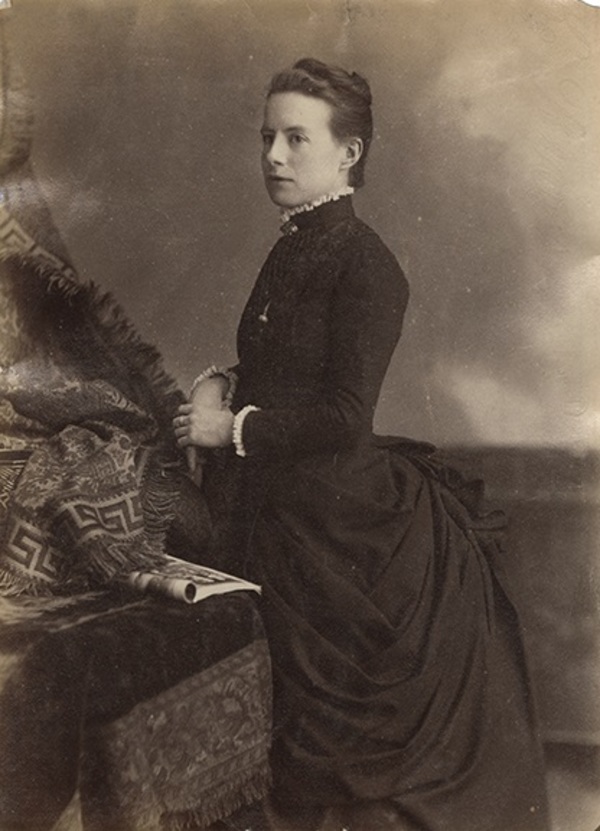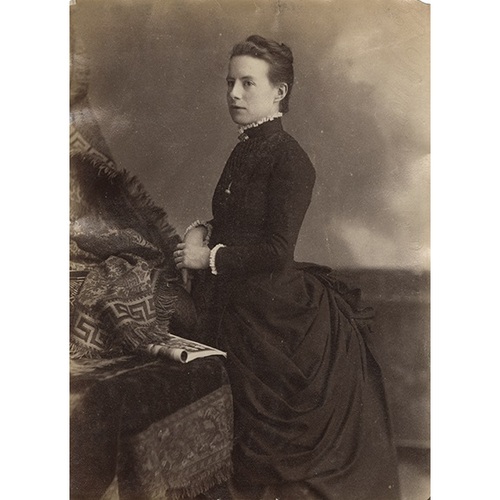
Source: Link
MACKINTOSH, KATE, teacher and musician; b. 24 Feb. 1853 in Halifax, daughter of John Mackintosh and Mary Catherine Crosskill; d. there unmarried 8 Sept. 1923.
Kate Mackintosh’s father died when she was four, leaving a large family in some disarray; otherwise, nothing is known of her formative years. In 1870 she graduated from the Normal School in Truro with a “Superior” standing and a first-class grade B licence. She was hired by Halifax’s Board of School Commissioners at $280 per annum and assigned to the Brunswick Street school for girls, the beginning of a 46-year career in the classroom.
Mackintosh soon attracted attention for outstanding ability. As early as 1876 she was commended for producing, with the principal at Brunswick Street, Catherine Miller, “more than 100 girls . . . creditably advanced in Geometry and Algebra.” In 1881 supervisor Benjamin Curren, an ardent classicist, thought “the very creditable examination of [her] class in Latin . . . worthy of special mention.” By the early 1880s Miller and Mackintosh had developed at Brunswick Street an advanced curriculum for senior girls, who were otherwise excluded from the few high-school programs then available in Halifax. According to the board’s annual report, the school achieved “its greatest success in the preparation of young ladies who wished to secure teachers’ licences. They rarely failed in their examinations, and when they became teachers they carried into their work much of Miss Miller’s conscientious, untiring industry and gentle spirit energized by Miss Mackintosh’s enthusiasm.” The unspoken economy of scale was that women hired with these minimum qualifications required only minimum remuneration.
In 1885 Halifax Academy opened as the city’s first dedicated, co-educational high school. Mackintosh, now holding a grade A licence and reputedly the first woman in Nova Scotia to achieve this qualification, was immediately appointed to teach history, grammar, physiology, and paedeutics (the science of education). Class enrolments averaged 68 by the mid 1890s, although chronic problems of attendance reduced the daily ratios. Mackintosh was applauded for her ability “with such perfect ease [to] control . . . large mixed classes, and inspire them all with the highest enthusiasm . . . self-respect, and . . . noble motives.” Despite her achievements and seniority – and the fact that her brother James Crosskill Mackintosh was the city’s mayor – further professional advancement was not possible for her; the school board remained biased in favour of university-educated men. There were, however, compensations. From 1888 Mackintosh was the highest-paid woman teacher in the city, her salary culminating in 1914–16 at $1,100 per annum. She was also one of the few women to penetrate the leadership of professional organizations. In the 1880s she served for three terms on the executive committee of the Provincial Educational Association of Nova Scotia and sat as well on its committee examining primary education. From its foundation in 1907 to at least 1913 she was a member of the board of management of the Halifax Teachers’ Pension System. She retired from teaching on 30 March 1916.
Mackintosh’s contribution to Halifax life extended far beyond the classroom. Somewhere in her youth she had learned to play the pipe organ, and from at least 1887 she served as organist at Brunswick Street Methodist Church. From 1891 she was both organist and choir director, presiding over newly installed equipment which she had helped to select during a visit to New York City. Under her guidance the church was acclaimed as having the best choir in Halifax. Such pre-eminence did not come cheaply. In addition to Mackintosh, who received an annual honorarium of $300, there were three paid soloists. Eventually the congregation could no longer sustain the expense; in 1916 the choir was reduced and the organist discreetly replaced.
During the 1890s, following specialized training at the Halifax Conservatory of Music [see Charles Henry Porter], Mackintosh gained recognition as a musical composer and arranger, the first woman in Nova Scotia known to have achieved such distinction. Although her talent was minor, she won praise for her arrangements of standard hymns, 17 of which were compiled as Tunes to favorite hymns; her setting for “Nearer, my God, to Thee” was included in the hymnal of the Methodist Church of Canada. Mackintosh reputedly continued to compose until her death, but little remains beyond patriotic pieces such as Our Canada and Mother-land beyond the sea, both published in 1897. Her obituary in the Halifax Evening Echo made the large claim that the latter was “sung in every school and played by every band throughout the Empire during the days of Queen Victoria’s Diamond Jubilee.” This was puffery, but the piece was definitely performed in Halifax under Kate’s direction, by 6,000 schoolchildren who massed at the Exhibition Building during the visit of Governor General Lord Aberdeen [Hamilton-Gordon*] and Lady Aberdeen [Marjoribanks*] in May 1897. The event was long remembered locally as “the grandest part” of the jubilee celebrations.
This work with schoolchildren notwithstanding, Mackintosh believed, as she wrote in the Halifax Herald in 1912, that it was “useless to look to the schools to provide good training in music . . . [since] the curriculum is already over-crowded.” Instead, noting that music “tends to elevate, morally and socially, the whole community,” she called for churches, musical clubs, and amateur musicians to cultivate a love of music in the young. Her interests found natural expression in the Ladies’ Musical Club of Halifax, of which she was a founding member in 1905. She served six terms as president, and was largely responsible for shaping the organization as a vehicle for fostering “a more perfect knowledge and understanding of vocal and instrumental music, and of musical literature.”
Following her retirement, Mackintosh devoted herself to the Halifax Women’s Club, described by the Herald as “the child of her vision and will.” Founded around 1920, with Mackintosh as president, the club had as its objective the establishment of a self-sustaining residence for unmarried women employed in the city’s clerical and paraprofessional workforce. The residence was maintained for some years, but much of the impetus died with Mackintosh and the initiative lapsed about 1926.
In death Mackintosh was eulogized as “the best known woman in the province of Nova Scotia.” She had been a mentor to nearly three generations of young people and a significant contributor to the local and national musical communities. Although her estate was valued at less than $200, this modest legacy reflected not so much the straitened circumstances of so many early women professionals, but instead a richness and generosity of spirit, expressed through devotion to music and the liberal arts, travel, close friendships, and the desire to influence and improve the lives of women.
[A fine photographic portrait of Kate Mackintosh is held at the NSARM.
The only article which Mackintosh is known to have written is “The future of music in Nova Scotia,” Halifax Herald, 31 Dec. 1912. Her extant sheet music includes “The Halifax Herald March,” in the Halifax Herald, 1 Oct. 1895, woman’s extra: 13; Our Canada: patriotic song, lyrics by E. Lawson Fenerty (Toronto, 1897; copy in NSARM, Oversize vert. file, 23, no.13); Mother-land beyond the sea (Halifax, 1897; copy in NSARM, MG 31, 26, no.13); and Diamond Jubilee; the army of the Lord, lyrics by J. T. Burgess (n.p., 1897; copy in NSARM, Vert. file, 98, no.12). A booklet of compositions by Mackintosh, Tunes to favorite hymns (Toronto, n.d.), includes 17 pieces and identifies her as organist of Brunswick Street Methodist Church, Halifax. l.k.y.].
Brunswick Street United Church (Halifax), Minutes of trustees, 1885–1949. Halifax County Court of Probate (Halifax), Estate papers, file no.10706. NA, RG 31, C1, 1901, Halifax, Ward 2. NSARM, MG 20, 183; RG 14, 69, minute-book, 1862–1916. Acadian Recorder (Halifax), 10 Sept. 1923. Evening Echo (Halifax), 10 Sept. 1923. Evening Mail (Halifax), 10 Sept. 1923. Halifax Herald, 10–11 Sept. 1923. K. A. Balcom, “From recruitment to retirement: female teachers in the public schools of late nineteenth century Halifax” (ma thesis, Dalhousie Univ., Halifax, 1993). Board of School Commissioners for the City of Halifax, Report, 1870–1916/17. M. I. Campbell, No other foundation: the history of Brunswick Street United Church and Mission with its Methodist inheritance (Hantsport, N.S., 1984). Directory, Halifax, 1870–1927. Halifax Ladies’ College and Conservatory of Music, [Calendar] ([Halifax]), 1888–95. Musical Halifax (Halifax), 1903/4.
Cite This Article
Lois K. Yorke, “MACKINTOSH, KATE,” in Dictionary of Canadian Biography, vol. 15, University of Toronto/Université Laval, 2003–, accessed December 12, 2025, https://www.biographi.ca/en/bio/mackintosh_kate_15E.html.
The citation above shows the format for footnotes and endnotes according to the Chicago manual of style (16th edition). Information to be used in other citation formats:
| Permalink: | https://www.biographi.ca/en/bio/mackintosh_kate_15E.html |
| Author of Article: | Lois K. Yorke |
| Title of Article: | MACKINTOSH, KATE |
| Publication Name: | Dictionary of Canadian Biography, vol. 15 |
| Publisher: | University of Toronto/Université Laval |
| Year of publication: | 2005 |
| Year of revision: | 2005 |
| Access Date: | December 12, 2025 |



